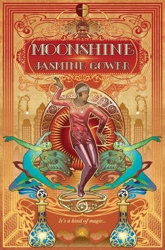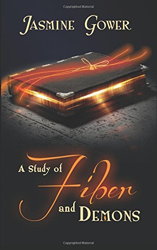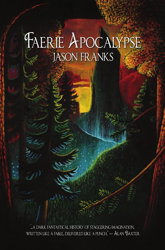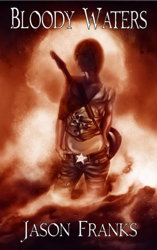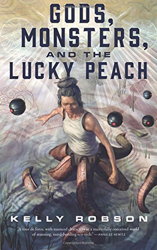
Yet another snowstorm has come and gone, the fourth in as many weeks, reminding me of that classic SNL skit about March coming in like a lion. That said, I’ll be happy to get to April in another week, because surely then we can all agree that winter is over and get on with the vernal weather. Meanwhile, I’m awaiting (like so many others) the release of the Hugo Awards short list so I can reach out to this year’s Campbell Award nominees and lure them here to talk about some of their meals.
But before any of that can happen, we need to continue on with the final EATING AUTHORS installment of this month, which is segue enough to introduce you to Jasmine Gower. She’s one of the many speculative fiction authors who call Portland, Oregon home (seriously, what’s in the water there?). Her work frequently explores themes of disability, gender, and sexuality. Moreover, her website includes a page detailing trigger warnings and specifies areas such as sex, violence, health, and general phobias that are to be found in her books.
Her latest novel, Moonshine, came out last month. It’s a mash-up of 1920’s Chicago and forbidden magic. What’s a young woman who’s only trying to make her way in the big city to do when magical bounty hunters come looking for her, just because she inherited some old fashioned power from her grandmother?

LMS: Welcome, Jasmine. Tell me about your most memorable meal.
JG: In the autumn after I earned my Bachelor’s degree in English, my mother and I took a trip celebrating my graduation to the United Kingdom, spending two weeks between the London area, Edinburgh, and Cardiff. (We had hoped to swing by the Gower Peninsula but decided to stay an extra day in Cardiff.) Being Americans from well-assimilated families, most of our connection to the UK came from extensive genealogy research done by my uncle and a lingering family penchant for traditional British food, which seems to be hugely unpopular with Americans who did not grow up eating it. We spent the majority of our trip in Edinburgh, and on our first night there (after being warned about the highly suspect quality of Scotland’s take on Mexican food) decided to get dinner at a pub near our hotel called the Arthur Conan Doyle. We been eating at pubs all week so far, but that had been down in Amersham–now that we were in Scotland, it was time to try Scottish pubs.
The menu, then, wasn’t terribly surprising. One of their most prominent dinner entrees was haggis. In America, of course, haggis is derided as the most disgusting of all British foods, fit only for uncivilized highland barbarians. I don’t get a lot of chances to reconnect to my family’s Scottish roots and I couldn’t remember ever having seen haggis on a menu back home, so I put aside my American hang-ups and ordered the haggis, just to say I’d given it a try. The American vision of haggis is admittedly a bit nebulous–something about sheep intestines, no real concept of the flavor, and it’s maybe slimy or chewy or something. No one really puts much thought into their disgust toward haggis before declaring it, so I wasn’t entirely sure what to expect.
I was surprised, then, when the dish brought out was effectively just ground sausage, not terribly different in texture and seasoning from the pork-based dish in the US, with a pile of mashed sweet potatoes and mashed parsnips each on the side. But I tend to favor miscellaneous sheep parts to miscellaneous pig parts, and although I like sausage, I found that the flavor of haggis suited my tastes much better. Had the only reason I had never sampled this delicious dish been haggis’ negative reputation in the US?
Well, it turns out, no. There was one other significant reason, which I only found out a few years later thinking back on the dinner I had had in the Arthur Conan Doyle. I was back home in the US, wondering where I might be able to find a restaurant that served the elusive, unfairly maligned Scottish dish. In Portland, Oregon, we have plenty of British-style pubs, including ones with a specifically Celtic bent, and yet I couldn’t find one that included haggis on the menu. When Google Maps was no help in my search, I turned then to regular Google and discovered the true reason why I couldn’t find this legendary Scottish meal.
Haggis is outlawed in the United States.
As it turned out, the United States banned the import of beef and sheep product from the UK back in the late 1980s during a mad cow disease scare, and one of haggis’ primary ingredients–sheep lung–remains banned to this day. And while you could still make haggis in the US with local sheep or by replacing the lung with some other ingredient, apparently few in the US seem inclined to try. Some Scottish ranchers and chefs seem to believe the US government is complicit in perpetuating targeted anti-Celtic legislation, and maybe this is true (historically, the US loves assimilationist legislation), but it’s probably more likely the result of some pork lobby in the US with a surprising amount of political clout trying to wedge out the competition. Whatever the reason, finding out that the delicious cultural dish I had sampled in Edinburgh was contraband in my home country was both a bit ridiculous and a bit outrageous.
And while I could certainly use any excuse available to me to go back to Scotland, I do wish I didn’t have to travel across the Atlantic Ocean to get another taste of this savory and tragically underappreciated meal.

Thanks, Jasmine. And now I know to blame the vast US pork lobby when conspiracy theories pop up. Perfect!
Next Monday: Another author and another meal!
Want to never miss an installment of EATING AUTHORS?
Click this link and sign up for a weekly email to bring you here as soon as they post.
#SFWApro
